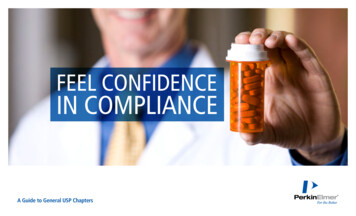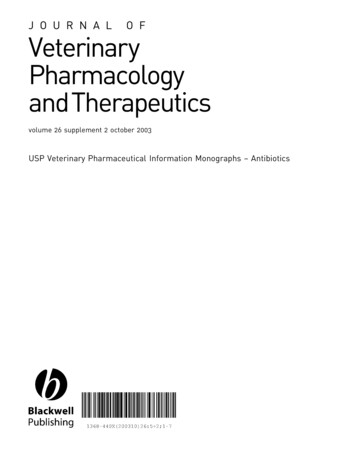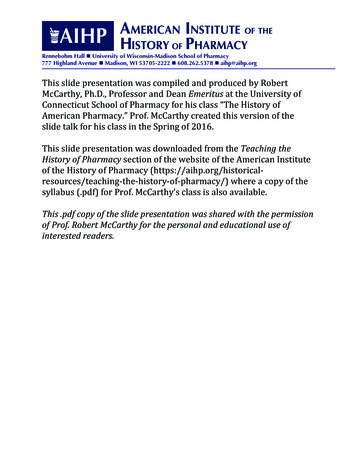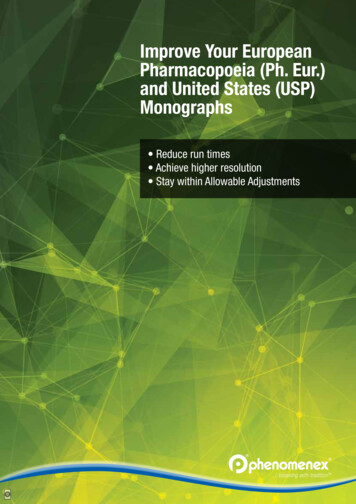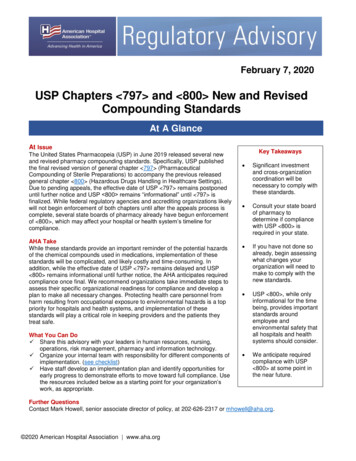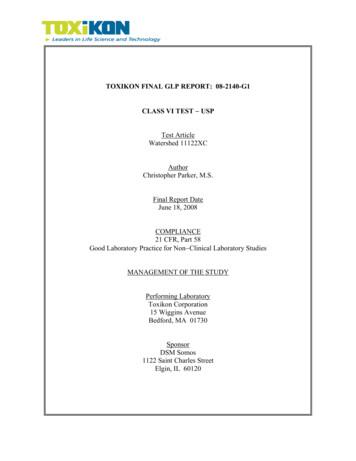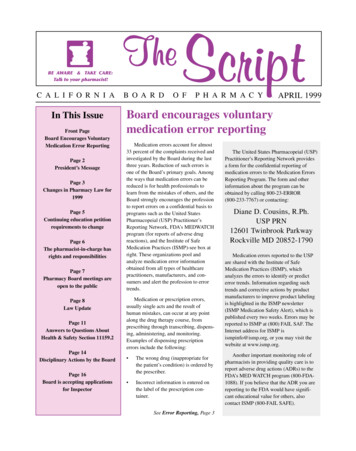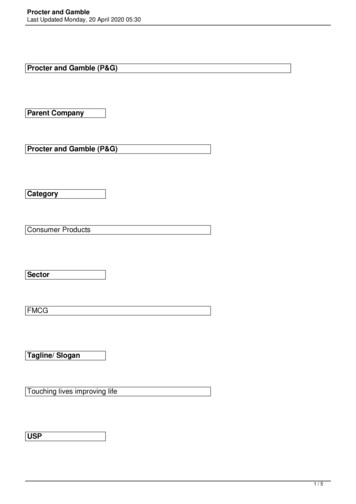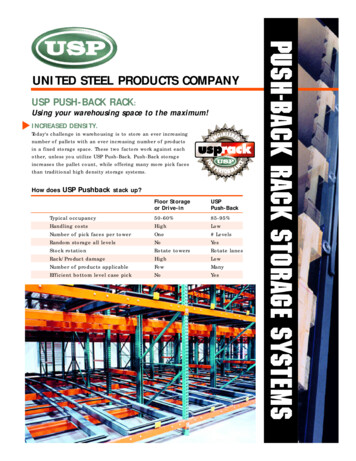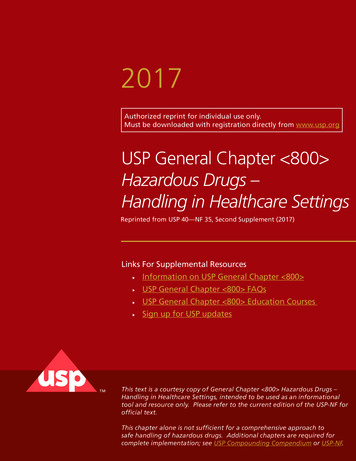
Transcription
2017Authorized reprint for individual use only.Must be downloaded with registration directly from www.usp.orgUSP General Chapter 800 Hazardous Drugs –Handling in Healthcare SettingsReprinted from USP 40—NF 35, Second Supplement (2017)Links For Supplemental Resources Information on USP General Chapter 800 USP General Chapter 800 FAQs USP General Chapter 800 Education Courses Sign up for USP updatesThis text is a courtesy copy of General Chapter 800 Hazardous Drugs –Handling in Healthcare Settings, intended to be used as an informationaltool and resource only. Please refer to the current edition of the USP-NF forofficial text.This chapter alone is not sufficient for a comprehensive approach tosafe handling of hazardous drugs. Additional chapters are required forcomplete implementation; see USP Compounding Compendium or USP-NF.
Accessed from 10.10.244.113 by uspstaff on Tue Sep 19 09:21:47 EDT 2017Errata to First Supplement to USP 40–NF 35Physical Tests / á800ñ Hazardous Drugs 1Add the following:á800ñ HAZARDOUS DRUGS—HANDLING IN HEALTHCARE SETTINGS(Chapter to become official July 1, 2018.) Refer to USP Notice of Intent to Revise (9/29/2017)This chapter describes practice and quality standards for handling hazardous drugs (HDs) to promote patient safety, workersafety, and environmental protection. Handling HDs includes, but is not limited to, the receipt, storage, compounding, dispensing, administration, and disposal of sterile and nonsterile products and preparations.This chapter applies to all healthcare personnel who handle HD preparations and all entities that store, prepare, transport, oradminister HDs (e.g., pharmacies, hospitals and other healthcare institutions, patient treatment clinics, physicians' practice facilities, or veterinarians' offices). Personnel who may potentially be exposed to HDs include, but are not limited to: pharmacists, pharmacy technicians, nurses, physicians, physician assistants, home healthcare workers, veterinarians, and veterinarytechnicians.Entities that handle HDs must incorporate the standards in this chapter into their occupational safety plan. The entity'shealth and safety management system must, at a minimum, include: A list of HDs Facility and engineering controls Competent personnel Safe work practices Proper use of appropriate Personal Protective Equipment (PPE) Policies for HD waste segregation and disposalThe chapter is organized into the following main sections:1. Introduction and Scope2. List of Hazardous Drugs3. Types of Exposure4. Responsibilities of Personnel Handling Hazardous Drugs5. Facilities and Engineering Controls6. Environmental Quality and Control7. Personal Protective Equipment8. Hazard Communication Program9. Personnel Training10. Receiving11. Labeling, Packaging, Transport, and Disposal12. Dispensing Final Dosage Forms13. Compounding14. Administering15. Deactivating, Decontaminating, Cleaning, and Disinfecting16. Spill Control17. Documentation and Standard Operating Procedures18. Medical SurveillanceGlossaryAppendicesAppendix 1: AcronymsAppendix 2: Examples of Designs for Hazardous Drug Compounding AreasAppendix 3: Types of Biological Safety CabinetsReferences2. LIST OF HAZARDOUS DRUGSThe National Institute for Occupational Safety and Health (NIOSH) maintains a list of antineoplastic and other HDs used inhealthcare. An entity must maintain a list of HDs, which must include any items on the current NIOSH list that the entity handles. The entity's list must be reviewed at least every 12 months. Whenever a new agent or dosage form is used, it should bereviewed against the entity's list.The NIOSH list of antineoplastic and other HDs provides the criteria used to identify HDs. These criteria must be used toidentify HDs that enter the market after the most recent version of the NIOSH list, or that the entity handles as an investiga-Official from December 1, 2017Copyright (c) 2017 The United States Pharmacopeial Convention. All rights reserved.Authorized reprint for individual use only. Must be downloaded with registration directly from www.usp.org1. INTRODUCTION AND SCOPE
Accessed from 10.10.244.113 by uspstaff on Tue Sep 19 09:21:47 EDT 20172 á800ñ Hazardous Drugs / Physical TestsErrata to First Supplement to USP 40–NF 35tional drug. If the information available on a drug is deemed insufficient to make an informed decision, consider the drug hazardous until more information is available.Box 1: Containment RequirementsSome dosage forms of drugs defined as hazardous may not pose a significant risk of direct occupational exposure because oftheir dosage formulation (e.g., tablets or capsules—solid, intact medications that are administered to patients without modifying the formulation). However, dust from tablets and capsules may present a risk of exposure by skin contact and/or inhalation. An assessment of risk may be performed for these dosage forms to determine alternative containment strategies and/orwork practices. If an assessment of risk is not performed, all HDs must be handled with all containment strategies defined inthis chapter.The assessment of risk must, at a minimum, consider the following: Type of HD (e.g., antineoplastic, non-antineoplastic, reproductive risk only) Dosage form Risk of exposure Packaging ManipulationIf an assessment of risk approach is taken, the entity must document what alternative containment strategies and/or workpractices are being employed for specific dosage forms to minimize occupational exposure. If used, the assessment of risk mustbe reviewed at least every 12 months and the review documented.3. TYPES OF EXPOSURERoutes of unintentional entry of HDs into the body include dermal and mucosal absorption, inhalation, injection, and ingestion (e.g., contaminated foodstuffs, spills, or mouth contact with contaminated hands). Containers of HDs have been shownto be contaminated upon receipt. Both clinical and nonclinical personnel may be exposed to HDs when they handle HDs ortouch contaminated surfaces. Table 1 lists examples of potential routes of exposure based on activity.Table 1. Examples of Potential Opportunities of Exposure Based on ActivityActivityPotential Opportunity of ExposureReceipt Contacting HD residues present on drug containers, individual dosage units, outer containers, work surfaces, orfloorsDispensing Counting or repackaging tablets and capsules Compounding and othermanipulationsCrushing or splitting tablets or opening capsulesPouring oral or topical liquids from one container to anotherWeighing or mixing componentsConstituting or reconstituting powdered or lyophilized HDsWithdrawing or diluting injectable HDs from parenteral containersExpelling air or HDs from syringesContacting HD residue present on PPE or other garmentsDeactivating, decontaminating, cleaning, and disinfecting areas contaminated with or suspected to becontaminated with HDs Maintenance activities for potentially contaminated equipment and devicesAdministration Generating aerosols during administration of HDs by various routes (e.g., injection, irrigation, oral, inhalation, ortopical application) Performing certain specialized procedures (e.g., intraoperative intraperitoneal injection or bladder instillation) Priming an IV administration setPatient-care activities Handling body fluids (e.g., urine, feces, sweat, or vomit) or body-fluid-contaminated clothing, dressings, linens,and other materialsSpills Spill generation, management, and disposalTransport Moving HDs within a healthcare settingWaste Collection and disposal of hazardous waste and trace contaminated wasteOfficial from December 1, 2017Copyright (c) 2017 The United States Pharmacopeial Convention. All rights reserved.Authorized reprint for individual use only. Must be downloaded with registration directly from www.usp.org Drugs on the NIOSH list that must follow the requirements in this chapter include:— Any HD API— Any antineoplastic requiring HD manipulation Drugs on the NIOSH list that do not have to follow all the containment requirements of this chapter if an assessment of risk is performed andimplemented include:— Final dosage forms of compounded HD preparations and conventionally manufactured HD products, including antineoplastic dosageforms that do not require any further manipulation other than counting or repackaging (unless required by the manufacturer) For dosage forms of other HDs on the NIOSH list, the entity may perform an assessment of risk to determine alternative containment strategiesand/work practices
Accessed from 10.10.244.113 by uspstaff on Tue Sep 19 09:21:47 EDT 2017Physical Tests / á800ñ Hazardous Drugs 3Errata to First Supplement to USP 40–NF 35Each entity must have a designated person who is qualified and trained to be responsible for developing and implementingappropriate procedures; overseeing entity compliance with this chapter and other applicable laws, regulations, and standards;ensuring competency of personnel; and ensuring environmental control of the storage and compounding areas. The designated person must thoroughly understand the rationale for risk-prevention policies, risks to themselves and others, risks of noncompliance that may compromise safety, and the responsibility to report potentially hazardous situations to the managementteam. The designated person must also be responsible for the oversight of monitoring the facility and maintaining reports oftesting/sampling performed in facilities, and acting on the results.All personnel who handle HDs are responsible for understanding the fundamental practices and precautions and for continually evaluating these procedures and the quality of final HDs to prevent harm to patients, minimize exposure to personnel, andminimize contamination of the work and patient-care environment.Change to read:5. FACILITIES AND ENGINEERING CONTROLSHDs must be handled under conditions that promote patient safety, worker safety, and environmental protection. Signs designating the hazard must be prominently displayed before the entrance to the HD handling areas. Access to areas where HDsare handled must be restricted to authorized personnel to protect persons not involved in HD handling. HD handling areasmust be located away from breakrooms and refreshment areas for personnel, patients, or visitors to reduce risk of exposure.Designated areas must be available for: Receipt and unpacking Storage of HDs Nonsterile HD compounding (if performed by the entity) Sterile HD compounding (if performed by the entity)Certain areas are required to have negative pressure from surrounding areas to contain HDs and minimize risk of exposure.Consideration should be given to uninterrupted power sources (UPS) for the ventilation systems to maintain negative pressurein the event of power loss.5.1 ReceiptAntineoplastic HDs and all HD APIs must be unpacked (i.e., removal from external shipping containers) in an area that isneutral/normal or negative pressure relative to the surrounding areas. HDs must not be unpacked from their external shippingcontainers in sterile compounding areas or in positive pressure areas.5.2 StorageHDs must be stored in a manner that prevents spillage or breakage if the container falls. Do not store HDs on the floor. Inareas prone to specific types of natural disasters (e.g., earthquakes) the manner of storage must meet applicable safety precautions, such as secure shelves with raised front lips.Antineoplastic HDs requiring manipulation other than counting or repackaging of final dosage forms and any HD API mustbe stored separately from non-HDs in a manner that prevents contamination and personnel exposure. These HDs must be stored in an externally ventilated, negative-pressure room with at least 12 air changes per hour (ACPH). Non-antineoplastic, reproductive risk only, and final dosage forms of antineoplastic HDs may be stored with other inventory if permitted by entity policy.Sterile and nonsterile HDs may be stored together, but HDs used for nonsterile compounding should not be stored in areasdesignated for sterile compounding to minimize traffic into the sterile compounding area.Refrigerated antineoplastic HDs must be stored in a dedicated refrigerator in a negative pressure area with at least 12 ACPH[e.g., storage room, buffer room, or containment segregated compounding area (C-SCA)]. If a refrigerator is placed in a negative pressure buffer room, an exhaust located adjacent to the refrigerator's compressor and behind the refrigerator should beconsidered.5.3 CompoundingEngineering controls are required to protect the preparation from cross-contamination and microbial contamination (if preparation is intended to be sterile) during all phases of the compounding process. Engineering controls for containment are divided into three categories representing primary, secondary, and supplementary levels of control. A containment primary engineering control (C-PEC) is a ventilated device designed to minimize worker and environmental HD exposure when directlyhandling HDs. The containment secondary engineering control (C-SEC) is the room in which the C-PEC is placed. Supplemen-Official from December 1, 2017Copyright (c) 2017 The United States Pharmacopeial Convention. All rights reserved.Authorized reprint for individual use only. Must be downloaded with registration directly from www.usp.org4. RESPONSIBILITIES OF PERSONNEL HANDLING HAZARDOUS DRUGS
Accessed from 10.10.244.113 by uspstaff on Tue Sep 19 09:21:47 EDT 20174 á800ñ Hazardous Drugs / Physical Teststal engineering controls [e.g., closed-system drug-transfer device (CSTD)] are adjunct controls to offer additional levels of protection. Appendix 2 provides examples for designs of HD compounding areas.Sterile and nonsterile HDs must be compounded within a C-PEC located in a C-SEC. The C-SEC used for sterile and nonsterile compounding must: Be externally vented(ERR 1-Jun-2016) Be physically separated (i.e., a different room from other preparation areas) Have an appropriate air exchange (e.g., ACPH) Have a negative pressure between 0.01 and 0.03 inches of water column relative to all adjacent areasThe C-PEC must operate continuously if it supplies some or all of the negative pressure in the C-SEC or if it is used for sterilecompounding. If there is any loss of power to the C-PEC, or if repair or moving occurs, all activities occurring in the C-PECmust be suspended immediately. If necessary, protect the unit by covering it appropriately per the manufacturer's recommendations. Once the C-PEC can be powered on, decontaminate, clean, and disinfect (if used for sterile compounding) all surfacesand wait the manufacturer-specified recovery time before resuming compounding.A sink must be available for hand washing. An eyewash station and/or other emergency or safety precautions that meet applicable laws and regulations must be readily available. Care must be taken to locate water sources and drains in areas wheretheir presence will not interfere with required ISO classifications. Water sources and drains must be located at least 1 meteraway from the C-PEC.For entities that compound both nonsterile and sterile HDs, the respective C-PECs must be placed in separate rooms, unlessthose C-PECs used for nonsterile compounding are sufficiently effective that the room can continuously maintain ISO 7 classification throughout the nonsterile compounding activity. If the C-PECs used for sterile and nonsterile compounding are placedin the same room, they must be placed at least 1 meter apart and particle-generating activity must not be performed whensterile compounding is in process.5.3.1 NONSTERILE COMPOUNDINGIn addition to this chapter, nonsterile compounding must follow standards in Pharmaceutical Compounding—Nonsterile Preparations á795ñ. A C-PEC is not required if manipulations are limited to handling of final dosage forms (e.g., counting or repackaging of tablets and capsules) that do not produce particles, aerosols, or gasses.The C-PECs used for manipulation of nonsterile HDs must be either externally vented (preferred) or have redundant–HEPAfilters in series. Nonsterile HD compounding must be performed in a C-PEC that provides personnel and environmental protection, such as a Class I Biological Safety Cabinet (BSC) or Containment Ventilated Enclosure (CVE). A Class II BSC or a compounding aseptic containment isolator (CACI) may also be used. For occasional nonsterile HD compounding, a C-PEC used forsterile compounding (e.g., Class II BSC or CACI) may be used but must be decontaminated, cleaned, and disinfected beforeresuming sterile compounding in that C-PEC. A C-PEC used only for nonsterile compounding does not require unidirectionalairflow because the critical environment does not need to be ISO classified.The C-PEC must be placed in a C-SEC that has at least 12 ACPH. Table 2 summarizes the engineering controls required fornonsterile HD compounding.Due to the difficulty of cleaning HD contamination, surfaces of ceilings, walls, floors, fixtures, shelving, counters, and cabinets in the nonsterile compounding area must be smooth, impervious, free from cracks and crevices, and non-shedding.Table 2. Engineering Controls for Nonsterile HD CompoundingC-PECC-SEC Requirements Externally vented (preferred) or redundant–HEPA filtered in series Examples: CVE, Class I or II BSC, CACI Externally vented 12 ACPH Negative pressure between 0.01 and 0.03 inches of water columnrelative to adjacent areas5.3.2 STERILE COMPOUNDINGIn addition to this chapter, sterile compounding must follow standards in á797ñ.All C-PECs used for manipulation of sterile HDs must be externally vented. Sterile HD compounding must be performed in aC-PEC that provides an ISO Class 5 or better air quality, such as a Class II or III BSC or CACI. Class II BSC types A2, B1, or B2are acceptable. For most known HDs, type A2 cabinets offer a simple and reliable integration with the ventilation and pressurization requirements of the C-SEC. Class II type B2 BSCs are typically reserved for use with volatile components. Appendix 3describes the different types of BSCs.A laminar airflow workbench (LAFW) or compounding aseptic isolator (CAI) must not be used for the compounding of anantineoplastic HD. A BSC or CACI used for the preparation of HDs must not be used for the preparation of a non-HD unlessthe non-HD preparation is placed into a protective outer wrapper during removal from the C-PEC and is labeled to require PPEhandling precautions.The C-PEC must be located in a C-SEC, which may either be an ISO Class 7 buffer room with an ISO Class 7 ante-room(preferred) or an unclassified containment segregated compounding area (C-SCA). If the C-PEC is placed in a C-SCA, the beyond-use date (BUD) of all compounded sterile preparations (CSPs) prepared must be limited as described in á797ñ for CSPsOfficial from December 1, 2017Copyright (c) 2017 The United States Pharmacopeial Convention. All rights reserved.Authorized reprint for individual use only. Must be downloaded with registration directly from www.usp.orgErrata to First Supplement to USP 40–NF 35
Accessed from 10.10.244.113 by uspstaff on Tue Sep 19 09:21:47 EDT 2017Errata to First Supplement to USP 40–NF 35Physical Tests / á800ñ Hazardous Drugs 5prepared in a segregated compounding area. Table 3 summarizes the engineering controls required for sterile HD compounding.Table 3. Engineering Controls for Sterile HD CompoundingC-PECISO Class 7 buffer room with an ISOClass 7 ante-roomUnclassified C-SCAC-SECMaximum BUD Externally vented Examples: Class II BSC orCACI Externally vented 30 ACPH Negative pressure between0.01 and 0.03 inches ofwater column relative toadjacent areasAs described in á797ñ Externally vented Examples: Class II BSC orCACI Externally vented 12 ACPH Negative pressure between0.01 and 0.03 inches ofwater column relative toadjacent areasAs described in á797ñ forCSPs prepared in a segregatedcompounding areaISO Class 7 buffer room with an ISO class 7 ante-room: The C-PEC is placed in an ISO Class 7 buffer room that has fixedwalls, HEPA-filtered supply air, a negative pressure between 0.01 and 0.03 inches of water column relative to all adjacent areasand a minimum of 30 ACPH.The buffer room must be externally vented. Because the room through which entry into the HD buffer room (e.g., anteroom or non-HD buffer room) plays an important role in terms of total contamination control, the following is required: Minimum of 30 ACPH of HEPA-filtered supply air Maintain a positive pressure of at least 0.02 inches of water column relative to all adjacent unclassified areas Maintain an air quality of ISO Class 7 or betterAn ISO Class 7 ante-room with fixed walls is necessary to provide inward air migration of equal cleanliness classified air intothe negative pressure buffer room to contain any airborne HD. A hand-washing sink must be placed in the ante-room at least1 meter from the entrance to the HD buffer room to avoid contamination migration into the negative pressure HD bufferroom.Although not a recommended facility design, if the negative-pressure HD buffer room is entered though the positive-pressure non-HD buffer room, the following is also required: A line of demarcation must be defined within the negative-pressure buffer room for donning and doffing PPE A method to transport HDs, HD CSPs, and HD waste into and out of the negative pressure buffer room to minimize thespread of HD contamination. This may be accomplished by use of a pass-through chamber between the negative-pressure buffer area and adjacent space. The pass-through chamber must be included in the facility's certification to ensurethat particles are not compromising the air quality of the negative-pressure buffer room. A refrigerator pass-through mustnot be used. Other methods of containment (such as sealed containers) may be used.HD CSPs prepared in an ISO Class 7 buffer room with an ISO Class 7 ante-room may use the BUDs described in á797ñ, basedon the categories of CSP, sterility testing, and storage temperature.Containment segregated compounding area (C-SCA): The C-PEC is placed in an unclassified C-SCA that has fixed walls, anegative pressure between 0.01 and 0.03 inches of water column relative to all adjacent areas, and a minimum of 12 ACPH.The C-SCA must be externally vented. A hand-washing sink must be placed at least 1 meter from C-PEC and may be eitherinside the C-SCA or directly outside the C-SCA.Only low- and medium-risk HD CSPs may be prepared in a C-SCA. HD CSPs prepared in the C-SCA must not exceed theBUDs described in á797ñ for CSPs prepared in a segregated compounding area.5.4 Containment Supplemental Engineering ControlsContainment supplemental engineering controls, such as CSTDs, provide adjunct controls to offer an additional level of protection during compounding or administration. Some CSTDs have been shown to limit the potential of generating aerosolsduring compounding. However, there is no certainty that all CSTDs will perform adequately. Until a published universal performance standard for evaluation of CSTD containment is available, users should carefully evaluate the performance claims associated with available CSTDs based on independent, peer-reviewed studies and demonstrated containment reduction.A CSTD must not be used as a substitute for a C-PEC when compounding. CSTDs should be used when compounding HDswhen the dosage form allows. CSTDs must be used when administering antineoplastic HDs when the dosage form allows.CSTDs known to be physically or chemically incompatible with a specific HD must not be used for that HD.6. ENVIRONMENTAL QUALITY AND CONTROLEnvironmental wipe sampling for HD surface residue should be performed routinely (e.g., initially as a benchmark and atleast every 6 months, or more often as needed, to verify containment). Surface wipe sampling should include: Interior of the C-PEC and equipment contained in itOfficial from December 1, 2017Copyright (c) 2017 The United States Pharmacopeial Convention. All rights reserved.Authorized reprint for individual use only. Must be downloaded with registration directly from www.usp.orgConfiguration
Accessed from 10.10.244.113 by uspstaff on Tue Sep 19 09:21:47 EDT 20176 á800ñ Hazardous Drugs / Physical Tests Pass-through chambers Surfaces in staging or work areas near the C-PEC Areas adjacent to C-PECs (e.g., floors directly under C-PEC, staging, and dispensing area) Areas immediately outside the HD buffer room or the C-SCA Patient administration areasThere are currently no studies demonstrating the effectiveness of a specific number or size of wipe samples in determininglevels of HD contamination. Wipe sampling kits should be verified before use to ensure the method and reagent used havebeen tested to recover a specific percentage of known marker drugs from various surface types found in the sampled area.There are currently no certifying agencies for vendors of wipe sample kits.There is currently no standard for acceptable limits for HD surface contamination. Common marker HDs that can be assayedinclude cyclophosphamide, ifosfamide, methotrexate, fluorouracil, and platinum-containing drugs. An example of measurablecontamination would be cyclophosphamide levels 1.00 ng/cm2, which were shown in some studies to result in uptake of thedrug in exposed workers. If any measurable contamination is found, the designated person must identify, document, and contain the cause of contamination. Such action may include reevaluating work practices, re-training personnel, performing thorough deactivation, decontamination, cleaning, and improving engineering controls. Repeat the wipe sampling to validate thatthe deactivation/decontamination and cleaning steps have been effective.7. PERSONAL PROTECTIVE EQUIPMENTPersonal Protective Equipment (PPE) provides worker protection to reduce exposure to HD aerosols and residues. AdditionalPPE may be required to handle the HDs outside of a C-PEC, such as treating a patient or cleaning a spill. The NIOSH list ofantineoplastic and other HDs provides general guidance on PPE for possible scenarios that may be encountered in healthcaresettings. Disposable PPE must not be re-used. Reusable PPE must be decontaminated and cleaned after use.Gowns, head, hair, shoe covers, and two pairs of chemotherapy gloves are required for compounding sterile and nonsterileHDs. Two pairs of chemotherapy gloves are required for administering antineoplastic HDs. Gowns shown to resist permeabilityby HDs are required when administering injectable antineoplastic HDs. For all other activities, the entity's SOP must describethe appropriate PPE to be worn based on its occupational safety plan and assessment of risk (if used). The entity must developSOPs for PPE based on the risk of exposure (see Types of Exposure) and activities performed.Appropriate PPE must be worn when handling HDs including during: Receipt Storage Transport Compounding (sterile and nonsterile) Administration Deactivation/decontamination, cleaning, and disinfecting Spill control Waste disposal7.1 GlovesWhen chemotherapy gloves are required, they must meet American Society for Testing and Materials (ASTM) standardD6978 (or its successor). Chemotherapy gloves should be worn for handling all HDs including non-antineoplastics and for reproductive risk only HDs. Chemotherapy gloves must be powder-free because powder can contaminate the work area and canadsorb and retain HDs. Gloves must be inspected for physical defects before use. Do not use gloves with pin holes or weakspots.When used for sterile compounding, the outer chemotherapy gloves must be sterile. Chemotherapy gloves should bechanged every 30 minutes unless otherwise recommended by the manufacturer's documentation and must be changed whentorn, punctured, or contaminated. Hands must be washed with soap and water after removing gloves.7.2 GownsWhen gowns are required, they must be disposable and shown to resist permeability by HDs. Gowns must be selected basedon the HDs handled. Disposable gowns made of polyethylene-coated polypropylene or other laminate materials offer betterprotection than those made of uncoated materials. Gowns must close in the back (i.e., no open front), be long sleeved, andhave closed cuffs that are elastic or knit. Gowns must not have seams or closures that could allow HDs to pass through.Cloth laboratory coats, surgical scrubs, isolation gowns, or other absorbent materials are not appropriate protective outerwear when handling HDs because they permit the permeation of HDs and can hold spilled drugs against the skin, therebyincreasing exposure. Clothing may also retain HD residue from contact, and may transfer to other healthcare workers or various surfaces. Washing of non-disposable clothing contaminated with HD residue should only be done according to facility pol-Official from December 1, 2017Copyright (c) 2017 The United States Pharmacopeial Convention. All rights reserved.Authorized reprint for individual use only. Must be downloaded with registration directly from www.usp.orgErrata to First Supplement to USP 40–NF 35
Accessed from 10.10.244.113 by uspstaff on Tue Sep 19 09:21:47 EDT 2017Errata to First Supplement to USP 40–NF 35Physical Tests / á800ñ Hazardous Drugs 7icy as drug residue may be transferred to other clothing. Potentially contaminated clothing must not be taken home under anycircumstances.Gowns must be changed per the manufacturer's information for permeation of the gown. If no permeation information isavailable for the gowns used, change them every 2–3 hours or immediately after a spill or splash. Gowns worn in HD handlingareas must not be worn to other areas in order to avoid spreading HD contamination and exposing other healthcare workers.Head and hair covers (including beard and moustache, if applicable), shoe covers, and sleeve covers provide protection fromc
Please refer to the current edition of the USP-NF for official text. This chapter alone is not sufficient for a comprehensive approach to safe handling of hazardous drugs. Additional chapters are required for complete implementation; see USP Compounding Compendium or USP-NF. 2017 Reprinted from USP 40—NF 35, Second Supplement (2017)
